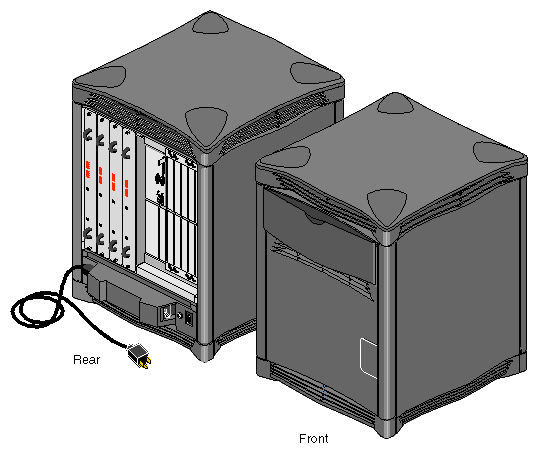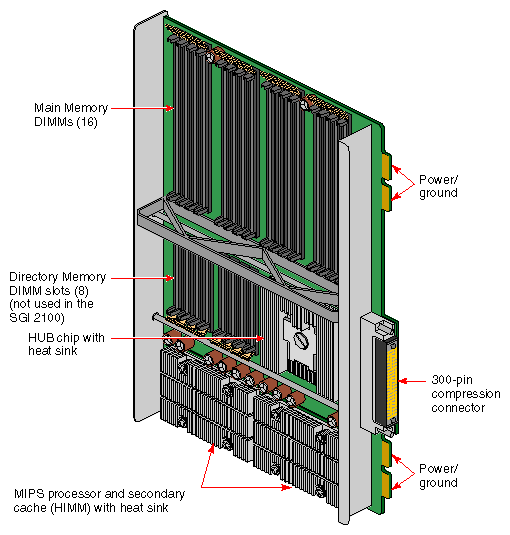The SGI 2100 system, model CMN A015, is a high-performance server that scales up to eight processors in a compact enclosure. This guide contains end-user hardware information about the system.
The SGI 2100 server comes with one to four combined CPU and memory boards called node boards. Each node board uses one or two MIPS™ 64-bit CPU microprocessors. The basic SGI 2100 uses one CPU and the system can use up to eight CPUs when fully configured.
The following standard features come with every SGI 2100 server:
One (CPU and memory) node board with one or two microprocessors.
Slots for up to 12 optional XIO™ boards. Note that the SGI 2100 server does not come with any VME™ slots.
An independent system status monitor (System Contoller) that records error information during any unplanned shutdown.
Spaces for up to five half-height single-connector assembly (SCA) SCSI disk drives, plus a 5.25-inch internal drive bay that supports a CD-ROM drive.
A minimum of 256 MB of RAM on each system node board installed.
additional hard disk drives
a system console ASCII terminal
memory upgrades
XIO boards providing additional I/O, mass storage connections, and graphics capabilities
a three-board optional peripheral component interconnect (PCI) internal adaptor that connects to the XIO slot directly below the BaseIO board (each of the three PCI slots in the adaptor supports a 25 watt PCI board)
The SGI 2100 server is similar in size to previous SGI deskside systems. However, there are some design differences between it and Origin systems, notably an upper limit of eight CPUs for a system.
The SGI 2100 server is a symmetric multiprocessing systems that uses a distributed shared-memory architecture called ccNUMA (cache-coherent Non-Uniform Memory Architecture).
The node boards within the system use links that differ from bus technology. While a bus is a resource that can be used only by one processor at a time, the communications fabric in the SGI 2100 makes connections from processor to processor as they are needed. Each node board contains either one or two processors, a portion of main memory, a directory to maintain cache coherence, and two interfaces:
The first interface connects to multiple I/O devices.
The second interface connects to other node boards.
This web of connections differs from a bus in the same way that multiple dimensions differ from a single dimension. You could describe a bus as a one-dimensional line while the SGI 2100 uses a multi-dimensional mesh.
The multiple data paths used are constructed as they are needed by router ASICs, which act as switches. As you add node boards, you add to and scale the system bandwidth.
Main memory on each node board in the system can be distributed and shared amongst the system microprocessors. This shared memory is accessible to all processors the interconnection fabric and can be accessed with low latency.
Each node board added to the system is another independent memory source, and each node board is capable of optionally supporting up to 4 GB of memory. A directory memory keeps track of information necessary for hardware coherency and protection.
Each node board uses a “Hub” ASIC that is the distributed shared-memory controller. It is responsible for providing all of the processors and I/O devices with transparent access to all of distributed memory in a cache-coherent manner. Cache coherence is the ability to keep data consistent throughout a system. In the SGI 2100, data can be copied and shared amongst all the processors and their caches. Moving data into a cache may cause the cached copy to become inconsistent with the same data stored elsewhere. The cache coherence protocol is designed to keep data consistent and to disperse the most-recent version of data to wherever it is being used.
Although memory is physically dispersed across the system node boards, special page migration hardware moves data into memory closer to a processor that frequently uses it. This page migration scheme reduces memory latency — the time it takes to retrieve data from memory. Although main memory is distributed, it is universally accessible and shared between all the processors in the system. Similarly, I/O devices are distributed among the nodes, and each device is accessible to every processor in the system.
The SGI 2100's microprocessor and primary memory are located on a processor board called a node board. Each node board (up to four maximum) in the SGI 2100 can house one or two MIPS microprocessors. Each CPU uses a customized two-way interleaved data cache, and has dedicated second-level cache support.
A high-performance bus interface links each CPU processor directly with supporting SRAM. The node board's main memory slots can be populated with 32-MB or 64-MB memory modules. See Figure 1-2 for an example node board illustration.
Note that directory memory is used only in large-scale rackmounted systems and is not used in the SGI 2100.
The standard I/O subsystem consists of a base I/O board assembly (BaseIO) that supports
two nine-pin serial ports (selectable for RS-232 or RS-422 operation)
a 100-Mb per second (100 Base-T) Ethernet connection
a 68-pin single-ended Ultra SCSI and SCSI-2 compatible connector
Additional I/O connection capabilities are available with optional XIO boards or by ordering an expanded version of the BaseIO.
XIO boards give the SGI 2100 system a wide range of optional interfaces in a manner similar to older VME interfaces. Optional XIO boards can support interfaces such as:
PCI
Fibre Channel
HIPPI
Ultra (FAST-20) SCSI and SCSI-2
ATM
Ethernet
Gigabit Ethernet
Digital Video (HDTV)
DIVO
GSN
Check with your SGI sales or support representative for information on these or other optional interfaces available on XIO boards.
The SGI 2100 enclosure uses a midplane to which boards, disk drives, and other devices can attach from both the front and rear of the system.
Located between the disk drive slots and the optional CD-ROM drive bay is the module System Controller (MSC). The MSC is a microprocessor-controlled subsystem that is mounted directly to the system midplane by way of an extender board. It monitors various system operations, including chassis temperature, system fan speed, midplane voltage levels, and the system clock.
When any operating parameter exceeds or drops past a specified limit, the MSC executes a controlled shutdown of the system. For details on using the MSC, see Chapter 6 in this document.
Each SGI 2100 comes standard with a system disk installed in drive bay one (next to the MSC). Four additional internal hard drives may be installed.
The CD-ROM drive is installed directly to the left of the MSC. Note that single-ended ultra SCSI and SCSI-2 drives are the only internal devices supported by the SGI 2100 system.
This section covers the basic requirements for physical location to ensure proper chassis operation.
The SGI 2100 chassis is designed to fit into a typical work environment. Take care to maintain the following operating conditions:
The chassis should be kept in a clean, dust-free location to reduce maintenance problems.
The available power should be rated for computer operation.
The chassis should be protected from harsh environments that produce excessive vibration, heat, and similar conditions.
The chassis should ideally have a six-inch (15-cm) minimum air clearance above the top. The first line of Table 1-1 shows the side clearances required if the chassis is positioned under a desk or other equipment and the top air clearance is less than six inches (15 cm). The side air clearances should always be at least as great as those listed on the second line of Table 1-1.
Table 1-1. Air Clearance Requirements for the SGI 2100 System
Top Clearance
Left Side
Right Side
Front
Back
6” (15 cm) or less
6” (15 cm)
6” (25 cm)
8” (20 cm)
8” (20 cm)
More than 6” (15 cm)
1” (2.5 cm)
1” (2.5 cm)
6” (15 cm)
6” (15 cm)
For more information on system specifications, see Table 2-1 in Chapter 2.
If you have additional questions concerning physical location or site preparation, see the Site Preparation for Origin Family and Onyx2 manual (P/N 007-3452-nnn). If you are unable to find the information you need, contact your SGI System Support Engineer (SSE) or other authorized support organization representative.

